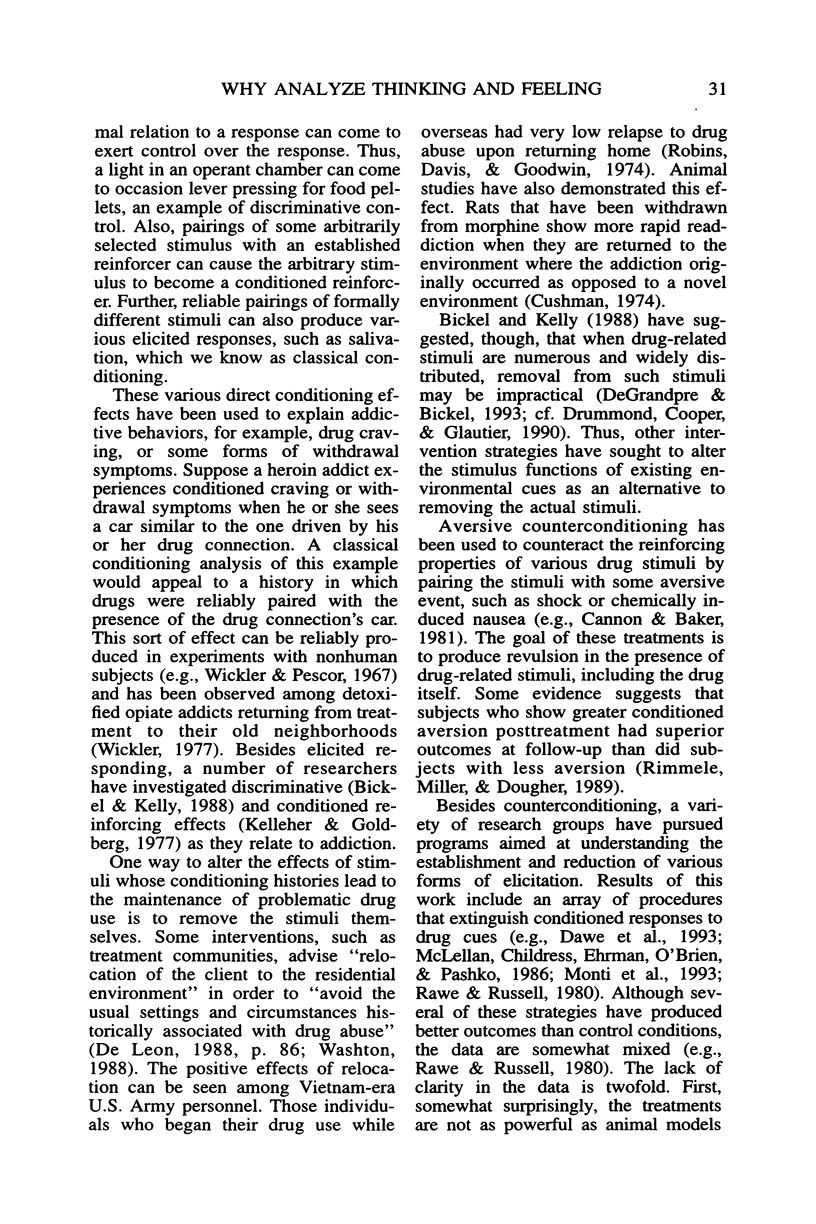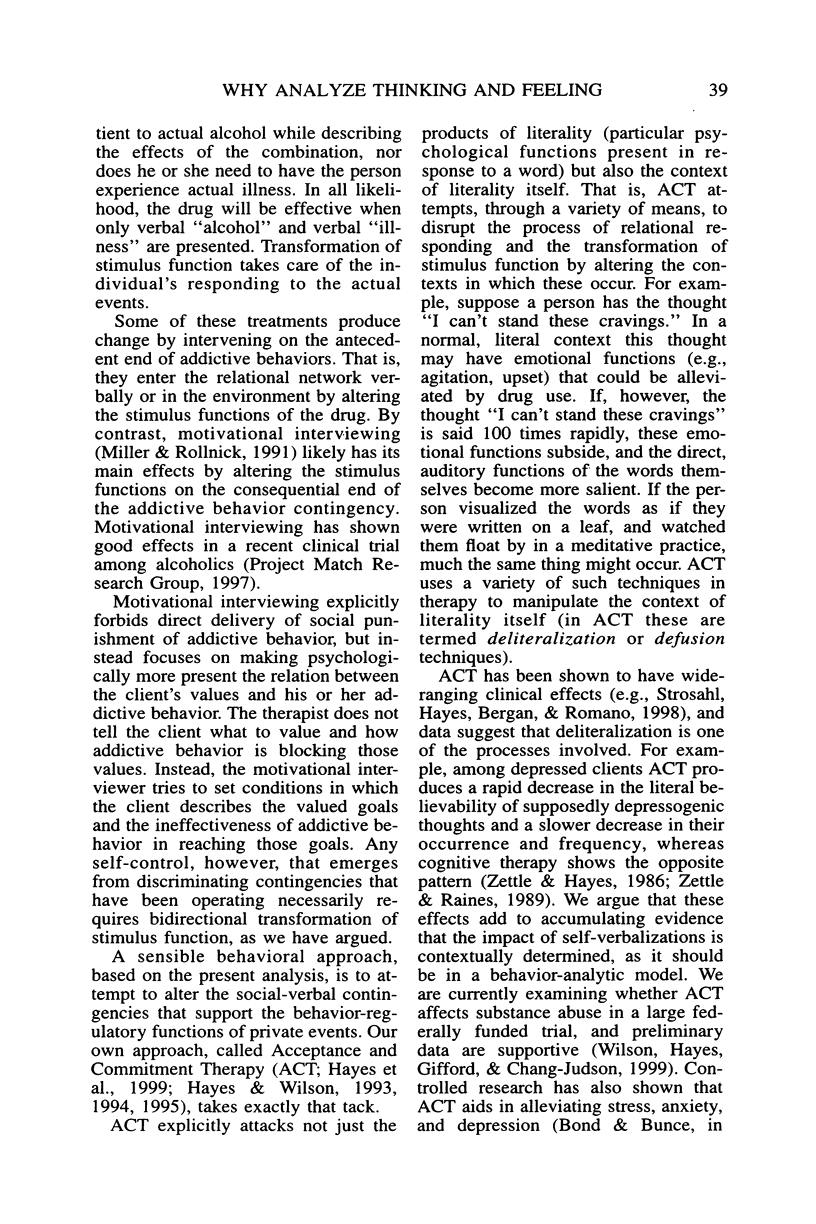Abstract
Behavior analysis has long accepted the legitimacy of the analysis of private events in a natural science of behavior. However, the topic has languished as a focus of empirical research in either applied or basic arenas. We argue that recent empirical work examining the bidirectional nature of verbal relations may shed light on the role of private events in complex human behavior. Skinner argued that although it would be possible to analyze private events, we need not, because thoughts and feelings were viewed as co-occuring products of the same contingencies that are responsible for changes in overt responses. However, the bidirectional transformation of stimulus function inherent in verbal behavior changes the way that private events participate in complex behavioral episodes for verbal organisms. We examine why we have reached such a conclusion, with special emphasis on the role of self-awareness. Finally, we conclude with an application of our analysis to the problem of substance abuse.
Keywords: cognition, emotion, private events, substance abuse, alcoholism, self-awareness, relational frame theory, verbal behavior, derived stimulus relations, bidirectionality
Full text
PDF


















Images in this article
Selected References
These references are in PubMed. This may not be the complete list of references from this article.
- Bandura A. Comments on the crusade against the causal efficacy of human thought. J Behav Ther Exp Psychiatry. 1995 Sep;26(3):179–190. doi: 10.1016/0005-7916(95)00034-w. [DOI] [PubMed] [Google Scholar]
- Barlow D. H., Leitenberg H., Agras W. S., Wincze J. P. The transfer gap in systematic desensitization: an analogue study. Behav Res Ther. 1969 May;7(2):191–196. doi: 10.1016/0005-7967(69)90032-1. [DOI] [PubMed] [Google Scholar]
- Bentall R. P., Lowe C. F. The role of verbal behavior in human learning: III. Instructional effects in children. J Exp Anal Behav. 1987 Mar;47(2):177–190. doi: 10.1901/jeab.1987.47-177. [DOI] [PMC free article] [PubMed] [Google Scholar]
- Bickel W. K., Kelly T. H. The relationship of stimulus control to the treatment of substance abuse. NIDA Res Monogr. 1988;84:122–140. [PubMed] [Google Scholar]
- Cannon D. S., Baker T. B. Emetic and electric shock alcohol aversion therapy: assessment of conditioning. J Consult Clin Psychol. 1981 Feb;49(1):20–33. doi: 10.1037//0022-006x.49.1.20. [DOI] [PubMed] [Google Scholar]
- Childress A. R., Ehrman R., McLellan A. T., MacRae J., Natale M., O'Brien C. P. Can induced moods trigger drug-related responses in opiate abuse patients? J Subst Abuse Treat. 1994 Jan-Feb;11(1):17–23. doi: 10.1016/0740-5472(94)90060-4. [DOI] [PubMed] [Google Scholar]
- Cushman P., Jr Detoxification of rehabilitated methadone patients: frequency and predictors of long-term success. Am J Drug Alcohol Abuse. 1974;1(3):393–408. doi: 10.3109/00952997409011032. [DOI] [PubMed] [Google Scholar]
- Dawe S., Powell J., Richards D., Gossop M., Marks I., Strang J., Gray J. A. Does post-withdrawal cue exposure improve outcome in opiate addiction? A controlled trial. Addiction. 1993 Sep;88(9):1233–1245. doi: 10.1111/j.1360-0443.1993.tb02146.x. [DOI] [PubMed] [Google Scholar]
- DeGrandpre R. J., Bickel W. K., Higgins S. T. Emergent equivalence relations between interoceptive (drug) and exteroceptive (visual) stimuli. J Exp Anal Behav. 1992 Jul;58(1):9–18. doi: 10.1901/jeab.1992.58-9. [DOI] [PMC free article] [PubMed] [Google Scholar]
- Devany J. M., Hayes S. C., Nelson R. O. Equivalence class formation in language-able and language-disabled children. J Exp Anal Behav. 1986 Nov;46(3):243–257. doi: 10.1901/jeab.1986.46-243. [DOI] [PMC free article] [PubMed] [Google Scholar]
- Dougher M. J., Augustson E., Markham M. R., Greenway D. E., Wulfert E. The transfer of respondent eliciting and extinction functions through stimulus equivalence classes. J Exp Anal Behav. 1994 Nov;62(3):331–351. doi: 10.1901/jeab.1994.62-331. [DOI] [PMC free article] [PubMed] [Google Scholar]
- Drummond D. C., Cooper T., Glautier S. P. Conditioned learning in alcohol dependence: implications for cue exposure treatment. Br J Addict. 1990 Jun;85(6):725–743. doi: 10.1111/j.1360-0443.1990.tb01685.x. [DOI] [PubMed] [Google Scholar]
- Drummond D. C., Glautier S. A controlled trial of cue exposure treatment in alcohol dependence. J Consult Clin Psychol. 1994 Aug;62(4):809–817. doi: 10.1037//0022-006x.62.4.809. [DOI] [PubMed] [Google Scholar]
- Dymond S., Barnes D. A transformation of self-discrimination response functions in accordance with the arbitrarily applicable relations of sameness, more than, and less than. J Exp Anal Behav. 1995 Sep;64(2):163–184. doi: 10.1901/jeab.1995.64-163. [DOI] [PMC free article] [PubMed] [Google Scholar]
- Friman P. C., Hayes S. C., Wilson K. G. Why behavior analysts should study emotion: the example of anxiety. J Appl Behav Anal. 1998 Spring;31(1):137–156. doi: 10.1901/jaba.1998.31-137. [DOI] [PMC free article] [PubMed] [Google Scholar]
- Hall J. F. Backward conditioning in Pavlovian type studies. Reevaluation and present status. Pavlov J Biol Sci. 1984 Oct-Dec;19(4):163–168. doi: 10.1007/BF03004514. [DOI] [PubMed] [Google Scholar]
- Hayes S. C., Brownstein A. J. Mentalism, behavior-behavior relations, and a behavior-analytic view of the purposes of science. Behav Anal. 1986 Fall;9(2):175–190. doi: 10.1007/BF03391944. [DOI] [PMC free article] [PubMed] [Google Scholar]
- Hayes S. C., Kohlenberg B. S., Hayes L. J. The transfer of specific and general consequential functions through simple and conditional equivalence relations. J Exp Anal Behav. 1991 Jul;56(1):119–137. doi: 10.1901/jeab.1991.56-119. [DOI] [PMC free article] [PubMed] [Google Scholar]
- Hayes S. C., Wilson K. G. Acceptance and commitment therapy: Altering the verbal support for experiential avoidance. Behav Anal. 1994 Fall;17(2):289–303. doi: 10.1007/BF03392677. [DOI] [PMC free article] [PubMed] [Google Scholar]
- Hayes S. C., Wilson K. G. Some applied implications of a contemporary behavior-analytic account of verbal events. Behav Anal. 1993 Fall;16(2):283–301. doi: 10.1007/BF03392637. [DOI] [PMC free article] [PubMed] [Google Scholar]
- Hayes S. C., Wilson K. G. The role of cognition in complex human behavior: a contextualistic perspective. J Behav Ther Exp Psychiatry. 1995 Sep;26(3):241–248. doi: 10.1016/0005-7916(95)00024-t. [DOI] [PubMed] [Google Scholar]
- Hayes S., Barnes D. Analyzing derived stimulus relations requires more than the concept of stimulus class. J Exp Anal Behav. 1997 Sep;68(2):235–244. doi: 10.1901/jeab.1997.68-235. [DOI] [PMC free article] [PubMed] [Google Scholar]
- Horne P. J., Lowe C. F. On the origins of naming and other symbolic behavior. J Exp Anal Behav. 1996 Jan;65(1):185–241. doi: 10.1901/jeab.1996.65-185. [DOI] [PMC free article] [PubMed] [Google Scholar]
- Kelleher R. T., Goldberg S. R. Fixed-interval responding under second-order schedules of food presentation or cocaine injection. J Exp Anal Behav. 1977 Nov;28(3):221–231. doi: 10.1901/jeab.1977.28-221. [DOI] [PMC free article] [PubMed] [Google Scholar]
- Leitenberg H., Agras S., Butz R., Wincze J. Relationship between heart rate and behavioral change during the treatment of phobias. J Abnorm Psychol. 1971 Aug;78(1):59–68. doi: 10.1037/h0031478. [DOI] [PubMed] [Google Scholar]
- Lipkens R., Hayes S. C., Hayes L. J. Longitudinal study of the development of derived relations in an infant. J Exp Child Psychol. 1993 Oct;56(2):201–239. doi: 10.1006/jecp.1993.1032. [DOI] [PubMed] [Google Scholar]
- Marlatt G. A. Cue exposure and relapse prevention in the treatment of addictive behaviors. Addict Behav. 1990;15(4):395–399. doi: 10.1016/0306-4603(90)90048-3. [DOI] [PubMed] [Google Scholar]
- McLellan A. T., Childress A. R., Ehrman R., O'Brien C. P., Pashko S. Extinguishing conditioned responses during opiate dependence treatment turning laboratory findings into clinical procedures. J Subst Abuse Treat. 1986;3(1):33–40. doi: 10.1016/0740-5472(86)90006-1. [DOI] [PubMed] [Google Scholar]
- Monti P. M., Rohsenow D. J., Abrams D. B., Binkoff J. A. Social learning approaches to alcohol relapse: selected illustrations and implications. NIDA Res Monogr. 1988;84:141–160. [PubMed] [Google Scholar]
- Monti P. M., Rohsenow D. J., Rubonis A. V., Niaura R. S., Sirota A. D., Colby S. M., Abrams D. B. Alcohol cue reactivity: effects of detoxification and extended exposure. J Stud Alcohol. 1993 Mar;54(2):235–245. doi: 10.15288/jsa.1993.54.235. [DOI] [PubMed] [Google Scholar]
- doi: 10.1901/jaba.1998.31-705. [DOI] [PMC free article] [Google Scholar]
- doi: 10.1901/jaba.1998.31-707. [DOI] [PMC free article] [Google Scholar]
- Pilgrim C., Galizio M. Relations between baseline contingencies and equivalence probe performances. J Exp Anal Behav. 1990 Nov;54(3):213–224. doi: 10.1901/jeab.1990.54-213. [DOI] [PMC free article] [PubMed] [Google Scholar]
- Pilgrim C., Galizio M. Reversal of baseline relations and stimulus equivalence: I. Adults. J Exp Anal Behav. 1995 May;63(3):225–238. doi: 10.1901/jeab.1995.63-225. [DOI] [PMC free article] [PubMed] [Google Scholar]
- Rachlin H., Green L. Commitment, choice and self-control. J Exp Anal Behav. 1972 Jan;17(1):15–22. doi: 10.1901/jeab.1972.17-15. [DOI] [PMC free article] [PubMed] [Google Scholar]
- Robins L. N., Davis D. H., Goodwin D. W. Drug use by U.S. Army enlisted men in Vietnam: a follow-up on their return home. Am J Epidemiol. 1974 Apr;99(4):235–249. doi: 10.1093/oxfordjournals.aje.a121608. [DOI] [PubMed] [Google Scholar]
- Roche B., Barnes D. A transformation of respondently conditioned stimulus function in accordance with arbitrarily applicable relations. J Exp Anal Behav. 1997 May;67(3):275–301. doi: 10.1901/jeab.1997.67-275. [DOI] [PMC free article] [PubMed] [Google Scholar]
- Shimp C. P. The local organization of behavior: discrimination of and memory for simple behavioral patterns. J Exp Anal Behav. 1981 Nov;36(3):303–315. doi: 10.1901/jeab.1981.36-303. [DOI] [PMC free article] [PubMed] [Google Scholar]
- Sidman M. Reading and auditory-visual equivalences. J Speech Hear Res. 1971 Mar;14(1):5–13. doi: 10.1044/jshr.1401.05. [DOI] [PubMed] [Google Scholar]
- Steele D., Hayes S. C. Stimulus equivalence and arbitrarily applicable relational responding. J Exp Anal Behav. 1991 Nov;56(3):519–555. doi: 10.1901/jeab.1991.56-519. [DOI] [PMC free article] [PubMed] [Google Scholar]
- Washton A. M. Preventing relapse to cocaine. J Clin Psychiatry. 1988 Feb;49 (Suppl):34–38. [PubMed] [Google Scholar]
- Wikler A., Pescor F. T. Classical conditioning of a morphine abstinence phenomenon, reinforcement of opioid-drinking behavior and "relapse" in morphine-addicted rats. Psychopharmacologia. 1967;10(3):255–284. doi: 10.1007/BF00401386. [DOI] [PubMed] [Google Scholar]
- Wikler A. The search for the psyche in drug dependence. A 35-year retrospective survey. J Nerv Ment Dis. 1977 Jul;165(1):29–40. doi: 10.1097/00005053-197707000-00002. [DOI] [PubMed] [Google Scholar]
- Wilson K. G., Hayes S. C. Resurgence of derived stimulus relations. J Exp Anal Behav. 1996 Nov;66(3):267–281. doi: 10.1901/jeab.1996.66-267. [DOI] [PMC free article] [PubMed] [Google Scholar]
- Zettle R. D., Rains J. C. Group cognitive and contextual therapies in treatment of depression. J Clin Psychol. 1989 May;45(3):436–445. doi: 10.1002/1097-4679(198905)45:3<436::aid-jclp2270450314>3.0.co;2-l. [DOI] [PubMed] [Google Scholar]



